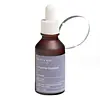What's inside
What's inside
 Key Ingredients
Key Ingredients

 Benefits
Benefits

 Concerns
Concerns

No concerns
 Ingredients Side-by-side
Ingredients Side-by-side

Water
Skin ConditioningButylene Glycol
HumectantNiacinamide
SmoothingBetaine
HumectantAvena Sativa Kernel Oil
Skin ConditioningIsododecane
EmollientGlycerin
HumectantCeramide Ns
Skin ConditioningEctoin
Skin ConditioningSodium PCA
HumectantAnthemis Nobilis Flower Water
MaskingSodium Polyacrylate
AbsorbentLecithin
EmollientShea Butter Ethyl Esters
EmollientCeramide NP
Skin ConditioningMorinda Citrifolia Callus Culture Lysate
Skin ConditioningCholesterol
EmollientCeramide As
Skin ConditioningCaprylhydroxamic Acid
1,2-Hexanediol
Skin ConditioningCentella Asiatica Extract
CleansingCitric Acid
BufferingPhospholipids
Skin ConditioningDisodium EDTA
Ceramide AP
Skin ConditioningXanthan Gum
EmulsifyingPolygonum Cuspidatum Root Extract
AntioxidantScutellaria Baicalensis Root Extract
AstringentLactic Acid
BufferingCamellia Sinensis Leaf Extract
AntimicrobialGlycyrrhiza Glabra Root Extract
BleachingGlycolipids
Skin ConditioningCaprylyl Glycol
EmollientChamomilla Recutita Flower Extract
MaskingRosmarinus Officinalis Leaf Extract
AntimicrobialTocopherol
AntioxidantGlycine
BufferingLinoleic Acid
CleansingSerine
MaskingGlutamic Acid
HumectantAspartic Acid
MaskingLeucine
Skin ConditioningAlanine
MaskingLysine
Skin ConditioningGlucose
HumectantArginine
MaskingTyrosine
MaskingPhenylalanine
MaskingThreonine
Proline
Skin ConditioningValine
MaskingIsoleucine
Skin ConditioningSodium Hyaluronate
HumectantHistidine
HumectantChondrus Crispus Extract
Skin ConditioningHydroxypropyltrimonium Hyaluronate
Hydrolyzed Hyaluronic Acid
HumectantSodium Acetylated Hyaluronate
HumectantHyaluronic Acid
HumectantSodium Hyaluronate Crosspolymer
HumectantHydrolyzed Sodium Hyaluronate
Skin ConditioningPotassium Hyaluronate
Skin ConditioningWater, Butylene Glycol, Niacinamide, Betaine, Avena Sativa Kernel Oil, Isododecane, Glycerin, Ceramide Ns, Ectoin, Sodium PCA, Anthemis Nobilis Flower Water, Sodium Polyacrylate, Lecithin, Shea Butter Ethyl Esters, Ceramide NP, Morinda Citrifolia Callus Culture Lysate, Cholesterol, Ceramide As, Caprylhydroxamic Acid, 1,2-Hexanediol, Centella Asiatica Extract, Citric Acid, Phospholipids, Disodium EDTA, Ceramide AP, Xanthan Gum, Polygonum Cuspidatum Root Extract, Scutellaria Baicalensis Root Extract, Lactic Acid, Camellia Sinensis Leaf Extract, Glycyrrhiza Glabra Root Extract, Glycolipids, Caprylyl Glycol, Chamomilla Recutita Flower Extract, Rosmarinus Officinalis Leaf Extract, Tocopherol, Glycine, Linoleic Acid, Serine, Glutamic Acid, Aspartic Acid, Leucine, Alanine, Lysine, Glucose, Arginine, Tyrosine, Phenylalanine, Threonine, Proline, Valine, Isoleucine, Sodium Hyaluronate, Histidine, Chondrus Crispus Extract, Hydroxypropyltrimonium Hyaluronate, Hydrolyzed Hyaluronic Acid, Sodium Acetylated Hyaluronate, Hyaluronic Acid, Sodium Hyaluronate Crosspolymer, Hydrolyzed Sodium Hyaluronate, Potassium Hyaluronate
Water
Skin ConditioningGlycereth-26
Humectant1,2-Hexanediol
Skin ConditioningButylene Glycol
HumectantGlycerin
HumectantArginine
MaskingCarbomer
Emulsion StabilisingEthylhexylglycerin
Skin ConditioningPolyglyceryl-10 Laurate
Skin ConditioningAdenosine
Skin ConditioningCaprylyl Glycol
EmollientCopper Tripeptide-1
Skin ConditioningHexapeptide-11
Skin ConditioningHexapeptide-9
Skin ConditioningPalmitoyl Pentapeptide-4
Skin ConditioningPalmitoyl Tripeptide-1
Skin ConditioningTripeptide-1
Skin Conditioning
 Reviews
Reviews

Ingredients Explained
These ingredients are found in both products.
Ingredients higher up in an ingredient list are typically present in a larger amount.
1,2-Hexanediol is a synthetic liquid and another multi-functional powerhouse.
It is a:
- Humectant, drawing moisture into the skin
- Emollient, helping to soften skin
- Solvent, dispersing and stabilizing formulas
- Preservative booster, enhancing the antimicrobial activity of other preservatives
Arginine is an amino acid that is important for human development. Your body uses is it to produce hair keratin and skin collagen.
As a cosmetic ingredient, Arginine has antioxidant properties and can also help repair damaged skin. This ingredient is derived either synthetically or from animals.
Arginine isn't fungal acne safe when used in the presence of other lipids (fats, fatty acids, oils, esters, etc). Oils and fats occur naturally within the skin, so take caution when using Arginine if you're prone to fungal acne.
Learn more about ArginineButylene Glycol (or BG) is used within cosmetic products for a few different reasons:
Overall, Butylene Glycol is a safe and well-rounded ingredient that works well with other ingredients.
Though this ingredient works well with most skin types, some people with sensitive skin may experience a reaction such as allergic rashes, closed comedones, or itchiness.
Learn more about Butylene GlycolCaprylyl Glycol is a humectant and emollient, meaning it attracts and preserves moisture.
It is a common ingredient in many products, especially those designed to hydrate skin. The primary benefits are retaining moisture, skin softening, and promoting a healthy skin barrier.
Though Caprylyl Glycol is an alcohol derived from fatty acids, it is not the kind that can dry out skin.
This ingredient is also used as a preservative to extend the life of products. It has slight antimicrobial properties.
Learn more about Caprylyl GlycolGlycerin is already naturally found in your skin. It helps moisturize and protect your skin.
A study from 2016 found glycerin to be more effective as a humectant than AHAs and hyaluronic acid.
As a humectant, it helps the skin stay hydrated by pulling moisture to your skin. The low molecular weight of glycerin allows it to pull moisture into the deeper layers of your skin.
Hydrated skin improves your skin barrier; Your skin barrier helps protect against irritants and bacteria.
Glycerin has also been found to have antimicrobial and antiviral properties. Due to these properties, glycerin is often used in wound and burn treatments.
In cosmetics, glycerin is usually derived from plants such as soybean or palm. However, it can also be sourced from animals, such as tallow or animal fat.
This ingredient is organic, colorless, odorless, and non-toxic.
Glycerin is the name for this ingredient in American English. British English uses Glycerol/Glycerine.
Learn more about GlycerinWater. It's the most common cosmetic ingredient of all. You'll usually see it at the top of ingredient lists, meaning that it makes up the largest part of the product.
So why is it so popular? Water most often acts as a solvent - this means that it helps dissolve other ingredients into the formulation.
You'll also recognize water as that liquid we all need to stay alive. If you see this, drink a glass of water. Stay hydrated!
Learn more about Water